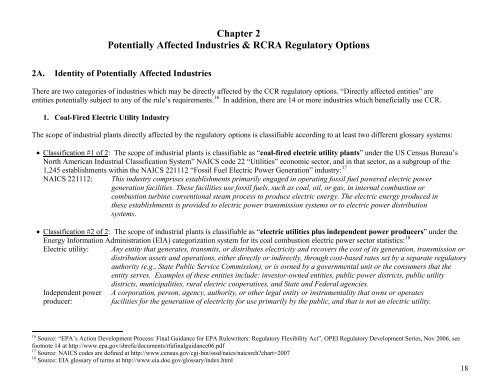Analysis - The Institute for Southern Studies
Analysis - The Institute for Southern Studies
Analysis - The Institute for Southern Studies
You also want an ePaper? Increase the reach of your titles
YUMPU automatically turns print PDFs into web optimized ePapers that Google loves.
Chapter 2<br />
Potentially Affected Industries & RCRA Regulatory Options<br />
2A. Identity of Potentially Affected Industries<br />
<strong>The</strong>re are two categories of industries which may be directly affected by the CCR regulatory options. “Directly affected entities” are<br />
entities potentially subject to any of the rule’s requirements. 16 In addition, there are 14 or more industries which beneficially use CCR.<br />
1. Coal-Fired Electric Utility Industry<br />
<strong>The</strong> scope of industrial plants directly affected by the regulatory options is classifiable according to at least two different glossary systems:<br />
Classification #1 of 2: <strong>The</strong> scope of industrial plants is classifiable as “coal-fired electric utility plants” under the US Census Bureau’s<br />
North American Industrial Classification System” NAICS code 22 “Utilities” economic sector, and in that sector, as a subgroup of the<br />
1,245 establishments within the NAICS 221112 “Fossil Fuel Electric Power Generation” industry: 17<br />
NAICS 221112: This industry comprises establishments primarily engaged in operating fossil fuel powered electric power<br />
generation facilities. <strong>The</strong>se facilities use fossil fuels, such as coal, oil, or gas, in internal combustion or<br />
combustion turbine conventional steam process to produce electric energy. <strong>The</strong> electric energy produced in<br />
these establishments is provided to electric power transmission systems or to electric power distribution<br />
systems.<br />
Classification #2 of 2: <strong>The</strong> scope of industrial plants is classifiable as “electric utilities plus independent power producers” under the<br />
Energy In<strong>for</strong>mation Administration (EIA) categorization system <strong>for</strong> its coal combustion electric power sector statistics: 18<br />
Electric utility: Any entity that generates, transmits, or distributes electricity and recovers the cost of its generation, transmission or<br />
distribution assets and operations, either directly or indirectly, through cost-based rates set by a separate regulatory<br />
authority (e.g., State Public Service Commission), or is owned by a governmental unit or the consumers that the<br />
entity serves. Examples of these entities include: investor-owned entities, public power districts, public utility<br />
districts, municipalities, rural electric cooperatives, and State and Federal agencies.<br />
Independent power A corporation, person, agency, authority, or other legal entity or instrumentality that owns or operates<br />
producer:<br />
facilities <strong>for</strong> the generation of electricity <strong>for</strong> use primarily by the public, and that is not an electric utility.<br />
16 Source: “EPA’s Action Development Process: Final Guidance <strong>for</strong> EPA Rulewriters: Regulatory Flexibility Act”, OPEI Regulatory Development Series, Nov 2006, see<br />
footnote 14 at http://www.epa.gov/sbrefa/documents/rfafinalguidance06.pdf<br />
17 Source: NAICS codes are defined at http://www.census.gov/cgi-bin/sssd/naics/naicsrch?chart=2007<br />
18 Source: EIA glossary of terms at http://www.eia.doe.gov/glossary/index.html<br />
18




